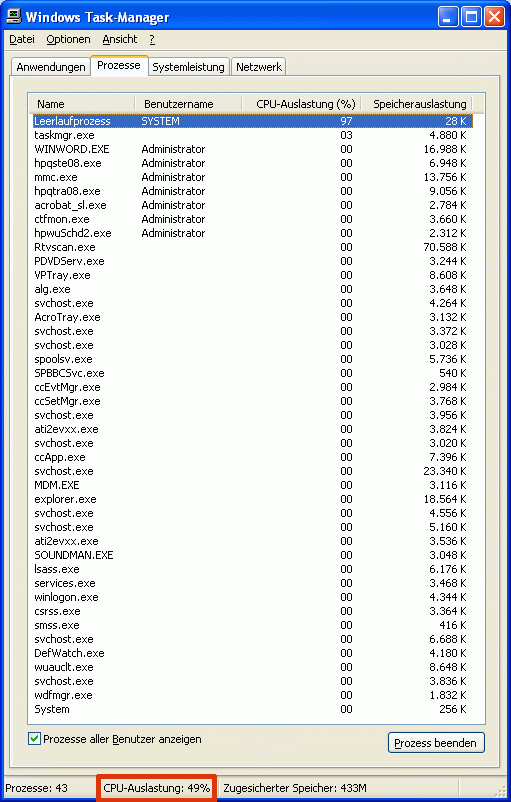How to Analyze Kernel Performance Bottlenecks (and Find that ATI’s Catalyst Drivers Cause 50% CPU Utilization)
Normally, finding the cause for high CPU utilization is easy – just start Task Manager. But what if the component consuming CPU cycles is a driver that runs in the kernel? In that case, there is no regular process Task Manager could attribute the usage to. You will see the “System Idle Process” at around 98%, but the “Performance” tab might indicate 50% CPU usage. How can that be?
Problem
I recently had this exact scenario when I installed a new graphics card in a private PC. Here is how it looked in Task Manager:
Analysis
It looks like some kernel-mode component eats up CPU cycles. But which one? The tool of choice here is Microsoft’s Kernrate Viewer. It collects kernel-mode CPU performance data and later displays a summary of the most active modules (drivers). This is what I got:
C:\Programme\KrView\Kernrates>Kernrate_i386_XP.exe
/==============================\
\==============================/
Date: 2009/12/24 Time: 14:46:59
Machine Name: OTTOSPC
Number of Processors: 1
PROCESSOR_ARCHITECTURE: x86
PROCESSOR_LEVEL: 15
PROCESSOR_REVISION: 2f02
Physical Memory: 2047 MB
Pagefile Total: 2613 MB
Virtual Total: 2047 MB
PageFile1: \??\C:\pagefile.sys, 720MB
OS Version: 5.1 Build 2600 Service-Pack: 3.0
WinDir: C:\WINDOWS
Kernrate User-Specified Command Line:
Kernrate_i386_XP.exe
Kernel Profile (PID = 0): Source= Time,
Using Kernrate Default Rate of 25000 events/hit
Starting to collect profile data
***> Press ctrl-c to finish collecting profile data
===> Finished Collecting Data, Starting to Process Results
------------Overall Summary:--------------
P0 K 0:00:19.562 (59.4%) U 0:00:00.078 ( 0.2%) I 0:00:13.281 (40.3%) DPC 0:00:00.000 ( 0.0%) Interrupt 0:00:19.3
43 (58.8%)
Interrupts= 14033581, Interrupt Rate= 426269/sec.
Total Profile Time = 32921 msec
BytesStart BytesStop BytesDiff.
Available Physical Memory , 1396867072, 1396502528, -364544
Available Pagefile(s) , 2206572544, 2206597120, 24576
Available Virtual , 2132484096, 2131435520, -1048576
Available Extended Virtual , 0, 0, 0
Total Avg. Rate
Context Switches , 8041, 244/sec.
System Calls , 71045, 2158/sec.
Page Faults , 447, 14/sec.
I/O Read Operations , 195, 6/sec.
I/O Write Operations , 36, 1/sec.
I/O Other Operations , 972, 30/sec.
I/O Read Bytes , 73962, 379/ I/O
I/O Write Bytes , 8838, 246/ I/O
I/O Other Bytes , 86695, 89/ I/O
-----------------------------
Results for Kernel Mode:
-----------------------------
OutputResults: KernelModuleCount = 132
Percentage in the following table is based on the Total Hits for the Kernel
Time 13125 hits, 25000 events per hit --------
Module Hits msec %Total Events/Sec
ati2mtag 6477 32921 49 % 4918592
hal 6284 32921 47 % 4772030
ntkrnlpa 196 32921 1 % 148841
VIDEOPRT 54 32921 0 % 41007
win32k 46 32921 0 % 34932
ati2dvag 27 32921 0 % 20503
ati3duag 8 32921 0 % 6075
ati2cqag 7 32921 0 % 5315
USBPORT 7 32921 0 % 5315
naveng 3 32921 0 % 2278
atikvmag 3 32921 0 % 2278
usbccgp 2 32921 0 % 1518
Ntfs 2 32921 0 % 1518
navex15 1 32921 0 % 759
watchdog 1 32921 0 % 759
SPBBCDrv 1 32921 0 % 759
SYMTDI 1 32921 0 % 759
SYMEVENT 1 32921 0 % 759
savrt 1 32921 0 % 759
usbehci 1 32921 0 % 759
CLASSPNP 1 32921 0 % 759
ACPI 1 32921 0 % 759
================================= END OF RUN ==================================
============================== NORMAL END OF RUN ==============================
It looks like the module “ati2mtag” consumed most CPU cycles.
Resolution
A quick web search later I had the solution: ATIs catalyst drivers seem to have a problem in certain scenarios that is related to HD audio. Disabling “Microsoft UAA Bus Driver for High Definition Audio” in Device Manager fixed this issue for me.
Here is a screen shot from Task Manager right after disabling said audio driver:









5 Comments
Hallo Helge,
ich nutze immer das Windows Performance Toolkit ( http://www.winvistaside.de/forum/index.php?showtopic=3090 und http://www.winvistaside.de/forum/index.php?showtopic=3037). Damit sieht man wunderbar wo es hakt.
André
Hi André,
the Windows Performance Toolkit along with its component XPerf is indeed a good alternative to Kernrate Viewer. Thanks for mentioning it.
Helge,
what’s your general experience of the performance and reliability of hardware made by gaming manufacturers, in a business oriented context? I’m talking about manufacturers like ATI, Nvidia and Creative.
My own is that more business oriented brands like Intel or even Via always perform well when the end user requirement is productivity apps or browsers, whereas manufacturers of more leading edge technologies like the big video card companies are facing a set of trade-offs that aren’t always ideal from a business point of view, and that this sometimes is evident in the reliability, if not the performance of their products.
I do not have too much experience with end-user and/or gaming hardware since I prefer the business series for private use, too. But from what I read and hear business devices generally are more reliable, more silent and more energy-efficient, not to mention better support & drivers.
I recall that Microsoft\’s internal statistics on crash dumps at one stage showed that a fairly large majority of these were caused by unsigned device drivers, and that most of those drivers were video card drivers, and that most of those were by a company whose name starts with N.